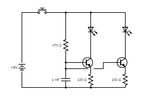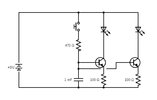Hey folks,
So, in my dumpster rummaging, I found a UV gel nail curing lamp. It has a 24VDC power supply (I metered it at more like 25.3VDC) and powers 30 UV LEDs pretty brightly in strings of 3 LEDs in series with 200 ohm resistors. I have no part numbers or other way to look up their specs, so I did some metering around and found that these LEDs appear to have a Vf of 7.2V, such that with 3 of them in series with a 200 ohm resistor, the resistor only gets about 3.5V across it, yielding a current draw of around 18mA. They are SMD LEDs and luckily I have a heat gun which enabled me to remove a few of them to play around with. I found that I could drive them nicely from a 9V battery using a 100ohm resistor to get around 18mA of current draw.
I did some reading on UV LEDs and learned that they have such high Vf because of the band gap needed to generate these relatively high frequency photons. Given that these things light up quite visibly, they obviously don't emit pure UV (which I assume is true of almost any UV LED), but they definitely get glow-in-the-dark toys to light up and highlighter marking fluoresce nicely under their light. I was wondering if it is possible to calculate their peak frequency based on their Vf of 7.2V. Are there other parameters I need in order to calculate this? Does it basically just come out to power = hν per unit time?
*I'm mostly just curious about the above. In case it's of any interest, I will be using these inside of ping-pong balls that will be the eyes on my niece's spider costume for Halloween. I came up with a stupid circuit that seems to work well with regular white LEDs and 9V battery, but I think I'll have to change some things around if I want to use these UV LEDs. I've attached what I've made on the breadboard. I'm sure it's all wrong, but at least it works. My goal was for my niece to be able to hit a N/O pushbutton sewn into her glove to make the eyes glow and that they would slowly fade out after she releases the button. I seem to have accomplished this with the 1000uF capacitor and the 100ohm emitter resistor. Haven't experimented yet with the UV LEDs. I'd love any suggestions if there's a better way to do this.
Thanks!
Celery
So, in my dumpster rummaging, I found a UV gel nail curing lamp. It has a 24VDC power supply (I metered it at more like 25.3VDC) and powers 30 UV LEDs pretty brightly in strings of 3 LEDs in series with 200 ohm resistors. I have no part numbers or other way to look up their specs, so I did some metering around and found that these LEDs appear to have a Vf of 7.2V, such that with 3 of them in series with a 200 ohm resistor, the resistor only gets about 3.5V across it, yielding a current draw of around 18mA. They are SMD LEDs and luckily I have a heat gun which enabled me to remove a few of them to play around with. I found that I could drive them nicely from a 9V battery using a 100ohm resistor to get around 18mA of current draw.
I did some reading on UV LEDs and learned that they have such high Vf because of the band gap needed to generate these relatively high frequency photons. Given that these things light up quite visibly, they obviously don't emit pure UV (which I assume is true of almost any UV LED), but they definitely get glow-in-the-dark toys to light up and highlighter marking fluoresce nicely under their light. I was wondering if it is possible to calculate their peak frequency based on their Vf of 7.2V. Are there other parameters I need in order to calculate this? Does it basically just come out to power = hν per unit time?
*I'm mostly just curious about the above. In case it's of any interest, I will be using these inside of ping-pong balls that will be the eyes on my niece's spider costume for Halloween. I came up with a stupid circuit that seems to work well with regular white LEDs and 9V battery, but I think I'll have to change some things around if I want to use these UV LEDs. I've attached what I've made on the breadboard. I'm sure it's all wrong, but at least it works. My goal was for my niece to be able to hit a N/O pushbutton sewn into her glove to make the eyes glow and that they would slowly fade out after she releases the button. I seem to have accomplished this with the 1000uF capacitor and the 100ohm emitter resistor. Haven't experimented yet with the UV LEDs. I'd love any suggestions if there's a better way to do this.
Thanks!
Celery







